Tel:0086 18231198596

News
Investigating the influence on the antimicrobial efficacy of ε-Polylysine hydrochloride.
TIME:2024-04-22
Understanding ε-Polylysine Hydrochloride
ε-Polylysine hydrochloride is a polycationic polymer derived from microbial fermentation, particularly from strains of Streptomyces albulus. It consists of multiple lysine residues linked together, forming a linear chain with potent antimicrobial properties. ε-Polylysine hydrochloride is effective against a wide range of bacteria, yeasts, and molds, making it a valuable antimicrobial agent for various applications.
The mechanism of action of ε-Polylysine hydrochloride involves disrupting microbial cell membranes, leading to leakage of cellular contents and inhibition of microbial growth. Its broad-spectrum activity, low toxicity, and biodegradability make it suitable for use in diverse industries where microbial control is essential.
Influence of Processing Parameters on Antimicrobial Efficacy
The antimicrobial efficacy of ε-Polylysine hydrochloride can be influenced by several processing parameters, including:
Production Method: The production method used to manufacture ε-Polylysine hydrochloride can impact its molecular structure, purity, and antimicrobial activity. Factors such as fermentation conditions, purification techniques, and post-processing treatments can affect the overall quality and effectiveness of the final product.
pH and Temperature: The pH and temperature conditions during the production and formulation of ε-Polylysine hydrochloride can influence its stability and antimicrobial activity. Optimal pH and temperature ranges must be maintained to ensure the integrity and efficacy of the peptide.
Concentration: The concentration of ε-Polylysine hydrochloride in formulations plays a crucial role in determining its antimicrobial effectiveness. Higher concentrations of the peptide may exhibit stronger antimicrobial activity but could also lead to formulation challenges or potential cytotoxicity concerns.
Formulation Factors: The formulation matrix and excipients used to deliver ε-Polylysine hydrochloride can impact its stability, solubility, and release kinetics. Factors such as pH, ionic strength, viscosity, and compatibility with other ingredients must be considered to optimize the antimicrobial efficacy of ε-Polylysine hydrochloride formulations.
Processing Conditions: The processing conditions, such as mixing, blending, homogenization, and sterilization, can affect the distribution, dispersion, and bioavailability of ε-Polylysine hydrochloride within formulations. Proper processing techniques are essential to ensure uniform distribution and maximize antimicrobial effectiveness.
Applications and Industries
The antimicrobial efficacy of ε-Polylysine hydrochloride has diverse applications across various industries:
Food Industry: In the food industry, ε-Polylysine hydrochloride is used as a natural preservative to inhibit the growth of spoilage organisms and foodborne pathogens in a wide range of products, including dairy, meat, seafood, bakery, and beverages.
Cosmetics and Personal Care: In cosmetics and personal care products, ε-Polylysine hydrochloride serves as an antimicrobial agent to prevent microbial contamination and extend the shelf life of formulations such as creams, lotions, serums, and makeup.
Agriculture: In agriculture, ε-Polylysine hydrochloride can be used to protect crops, fruits, vegetables, and livestock from microbial diseases and spoilage during production, harvesting, storage, and transportation.
Pharmaceuticals: In pharmaceutical formulations, ε-Polylysine hydrochloride offers antimicrobial protection for oral, topical, and injectable products, enhancing their stability and safety for patient use.
Future Directions and Innovations
Future research and innovation in the field of ε-Polylysine hydrochloride aim to:
Optimize Production Methods: Develop efficient and scalable production methods for ε-Polylysine hydrochloride with enhanced purity, yield, and antimicrobial activity.
Enhance Formulation Techniques: Explore novel formulation techniques, such as encapsulation, nanoemulsions, and controlled-release systems, to improve the stability, efficacy, and delivery of ε-Polylysine hydrochloride in various applications.
Evaluate Synergistic Combinations: Investigate synergistic combinations of ε-Polylysine hydrochloride with other antimicrobial agents or natural compounds to enhance antimicrobial efficacy and broaden the spectrum of activity against resistant pathogens.
Address Safety and Regulatory Considerations: Conduct comprehensive safety assessments and regulatory evaluations to ensure the safety, efficacy, and compliance of ε-Polylysine hydrochloride formulations for human, animal, and environmental health.
Conclusion
In conclusion, ε-Polylysine hydrochloride holds significant potential as a natural antimicrobial agent with diverse applications across multiple industries. However, its antimicrobial efficacy is influenced by various processing parameters, highlighting the importance of optimizing production methods, formulation techniques, and application strategies. By understanding the factors that impact the antimicrobial efficacy of ε-Polylysine hydrochloride and advancing research and innovation in this field, stakeholders can harness its full potential to address microbial contamination challenges and promote safer and more sustainable products and processes.

 CONTACT
CONTACT




